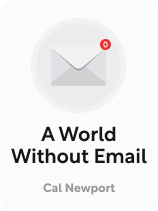

This article is an excerpt from the Shortform book guide to "A World Without Email" by Cal Newport. Shortform has the world's best summaries and analyses of books you should be reading.
Like this article? Sign up for a free trial here.
What is Cal Newport’s A World Without Email about? What are the main takeaways of the book?
In A World Without Email, Cal Newport says that constantly checking emails is what’s making knowledge workers unhappy and less productive. Newport contends email doesn’t have to be the default way we work, and he proposes solutions to get the most out of knowledge workers’ expertise while also making them happier employees.
Read below for a brief overview of A World Without Email.
A World Without Email by Cal Newport
In A World Without Email, Cal Newport argues that email, and the relentless requests and distractions it introduces, makes knowledge workers less productive and more unhappy. Rather than dedicating focused time to the work they were hired to do, knowledge workers spend most of their days responding to and checking for unexpected requests which, because they’re part of a team, they feel pressured to fulfill immediately.
Cal Newport has written several other books on productivity and focus, including Deep Work, So Good They Can’t Ignore You, and Digital Minimalism. He teaches computer science at Georgetown University and hosts the Deep Questions podcast.
A World Without Email builds on the popularity of his earlier works. In it, he discusses the problems created by what he calls a hyperactive hive mind workflow, in which all members of an organization are in constant, frantic, and often unnecessary communication. The hyperactive hive mind workflow prevents companies from getting the full value of the knowledge worker’s knowledge, because those workers are too busy performing low-value administrative tasks. It also makes knowledge workers miserable and stressed by constant demands on their time.
However, Newport doesn’t believe the workplace must be this way and proposes three changes to the systems that govern how knowledge workers produce work:
- Change the workflows that determine how employees work.
- Change the methods of communication that determine how employees connect.
- Change the nature of the work employees complete.
Our Current Approach to Work: The Hyperactive Hive Mind Workflow
Newport argues that most knowledge workers structure their work days around responding to unscheduled emails and instant messages rather than around the knowledge work they were hired to do. A 2019 study showed that the average employee sent and received 126 emails a day, and another study showed that employees check their instant messenger app once a minute on average and their inboxes 77 times a day. A third study indicated that many knowledge workers can only perform about an hour of uninterrupted knowledge work a day. The rest of their day is spent responding to a barrage of incoming emails and messages.
Newport coined a term to describe this state of work that revolves around responding to impromptu messages: the hyperactive hive mind workflow (we’ll refer to this as HHMW).
Don’t Let Urgent Tasks Hinder Important Tasks
One solution to the problem that these studies reveal—the inability to focus because of constant requests for attention—might be to better distinguish important tasks from urgent tasks. Important tasks contribute value to the company, while urgent ones don’t take much time to perform but don’t contribute much value to the company. For example, an important task would be devising a new marketing strategy, which will improve a company’s sales.
An urgent task, on the other hand, would be responding to a request from a colleague about where certain files are located—this task is easy to perform but doesn’t contribute much value to the business. Research shows that workers often devote the majority of their day to urgent tasks, leaving them unable to get to important tasks—the tasks that bring more ultimate value. When this happens, employees often end up addressing important tasks outside of work hours, allowing work to intrude on their personal time. Productivity experts advise that to prevent this, you should block off dedicated time every day for important tasks during which you make yourself unavailable for any other requests.
What Feeds the Hyperactive Hive Mind Workflow?
What factors create and drive the HHMW? Newport points to four catalysts:
- Fear of alienation from your group
- The misconception that asynchronous communication is easier
- Pressure to be increasingly responsive
- Our conception of the knowledge worker
Newport also writes that there are four drawbacks of the HHMW, both for companies and individuals.
- Knowledge workers constantly multitask and are thus less productive
- Knowledge workers do more work than necessary
- Written communication can be ambiguous
- Workers are miserable
A Better Approach to Work: Solutions to the Hyperactive Hive Mind Workflow
Newport proposes three solutions to HHMW, all of which are predicated on his principle of attention capital. Let’s first explore this principle and then dive into his three solutions.
The Attention Capital Principle: Brainpower Must Be Optimally Harnessed
Newport’s attention capital principle is based on the idea that the most value-generating resource knowledge workers have is their brainpower, or what he calls their attention capital. Companies must extract the value of that brainpower to produce high-quality work. But not all value-extraction systems are equally effective. Therefore, to derive the greatest value from knowledge workers’ brainpower, companies must put in place optimal workflows and systems—this is the attention capital principle.
Let’s illustrate the attention capital principle through an example: You’re an architect who possesses knowledge and skill—in other words, attention capital. If you spend most of your day answering emails rather than designing buildings, your company isn’t extracting much value from your expertise in architecture: All it’s getting from you is a bunch of emails. However, if your company sets up a workflow wherein you can work on blueprints for several uninterrupted hours, it extracts far more value from your attention capital.
In this principle, Newport makes an important distinction between attention capital and the systems and workflows that extract value from it. Managers shouldn’t push knowledge workers to produce more or better attention capital—because knowledge workers are experts and know best how to produce attention capital—but managers should develop workflows and systems to derive the most value from the attention capital.
In our architect example, the manager shouldn’t ask the architect to arrive early to work or to work faster to generate more ideas: The architect knows best how to do their job. Instead, the manager could set up a regular meeting with the architect to check on progress and tell colleagues the architect can’t be bothered during set times of the day that the architect identified. These are workflows that let the company get the most value from the architect’s expertise.
Now that we’ve covered the attention capital principle, let’s describe Newport’s three solutions for improving the systems companies use to extract the greatest value from their knowledge workers’ brainpower.
Solution #1: The Process Principle
The process principle is the idea that companies should institute processes—systems and workflows—that enhance the performance of knowledge workers and make their work more enjoyable.
(Shortform note: Newport’s choice of the word “process” may seem arbitrary because “process” is a loose term that doesn’t in itself communicate much about this idea. However, a formal definition of a “work process” is a system that generates value for a company. This additional context clarifies the principle somewhat—perhaps an alternative, more specific name for it could be the “value-generation principle.”)
Newport feels that many companies fear instituting structured processes for their knowledge workers because these reduce the autonomy and flexibility considered integral to effective knowledge work. In reality, while structures may marginally reduce autonomy and flexibility, they more importantly keep the workplace equitable and efficient: Without formal processes, humans tend to try to do as little work as possible, and influential employees pawn work off on hard-working colleagues.
(Shortform note: The freelancer might be more familiar than anyone with the need to balance autonomy and flexibility with discipline and processes to be optimally productive. Freelancers understand that while autonomy is nice, if you don’t institute certain processes and rules for yourself, you’ll never get anything done. More likely, you’ll abuse your “future self” by procrastinating or forcing yourself to work on weekends to meet deadlines.)
Newport recommends two processes in particular: task board-based and automated.
Solution #2: The Protocol Principle
Beyond setting up workflows that efficiently extract value from knowledge work, Newport recommends that companies set up rules for how people communicate to reduce inefficient cognitive switching and unnecessary work. This is the protocol principle. Rules can be challenging to implement in the short term but can result in greater productivity in the long term.
(Shortform note: Like “the process principle,” the “protocol principle” is a slightly vague term, as we use the word protocol loosely across many contexts. We might consider “communication conventions” as a substitute for “protocol,” as this perhaps more pointedly conveys the idea that a workplace must institute standards for communication. )
Solution #3: The Specialization Principle
Newport’s last solution to optimizing the systems that extract value from knowledge work is to have workers focus on fewer tasks and do them with higher quality and accountability—in other words, to specialize. This means you don’t lose productivity by multitasking, and you don’t waste time answering unimportant questions.
(Shortform note: Other time management specialists agree with Newport that to produce the highest-quality work, you must specialize. In Eat That Frog, Brian Tracy even specifies that three tasks at work let you add the most value, so you should figure out what those three tasks are, and move all other responsibilities off your plate.)

———End of Preview———
Like what you just read? Read the rest of the world's best book summary and analysis of Cal Newport's "A World Without Email" at Shortform.
Here's what you'll find in our full A World Without Email summary:
- How email makes knowledge workers less productive and more unhappy
- How to improve the channels through which people communicate
- Why you should implement protocols to reduce unnecessary work






